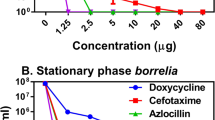Summary
The persistence ofBorrelia burgdorferi in patients treated with antibiotics is described. The diagnosis of Lyme disease is based on clinical symptoms, epidemiology and specific IgG and IgM antibody titers toB. burgdorferi in serum. Antibiotic therapy may abrogate the antibody response to the infection as shown in our patients.B. burgdorferi may persist as shown by positive culture in MKP-medium; patients may have subclinical or clinical disease without diagnostic antibody titers toB. burgdorferi. We conclude that early stage of the disease as well as chronic Lyme disease with persistence ofB. burgdorferi after antibiotic therapy cannot be excluded when the serum is negative for antibodies againstB. burgdorferi.
Zusammenfassung
Es wird über die Persistenz vonBorrelia burgdorferi bei sechs Patienten berichtet. Nach dem Zecken- bzw. Insektenstich und Erythema migrans konnteB. burgdorferi noch Wochen nach der Antibiotikatherapie nachgewiesen werden. Serologische Befunde waren außer bei einem Patienten negativ. Diese Ergebnisse bestätigen unsere früheren Beobachtungen und sprechen dafür, dß die Antibiotikabehandlung die Antikörperbildung gegenB. burgdorferi beeinflussen kann. Ferner zeigen diese Ergebnisse und Beobachtungen, daß nicht nur im Frühstadium der Lyme Borreliose, sondern auch in chronischen Stadien bzw. bei Persistenz des Erregers der Nachweis von Antikörpern negativ bleiben kann.
Similar content being viewed by others
References
Steere, A. C., Malawista, S. E., Newman, J. H., Spieler, P. N., Bartenhagen, N. H. Antibiotic therapy in Lyme disease. Ann. Intern. Med. 93 (1980) 1–8.
Steere, A. C., Hutchinson, G. J., Rahn, D. W., Sinal, L. H., Craft, J. E., De Sanna, E. T., Malawista, S. E. Treatment of the early manifestations of Lyme disease. Ann. Intern. Med. 99 (1983) 22–26.
Steere, A. C., Pachner, A. R., Malawista, S. E. Neurological abnormalities of Lyme disease: successful treatment with high-dose intravenous penicillin. Ann. Intern. Med. 99 (1983) 767–772.
Weber, K. Treatment of Lyme disease. Ann. Intern. Med. 94 (1981) 137.
Kristoferitsch, W., Baumhackl, U., Sluga, E., Stanek, G., Zeiler, K. High dose penicillin in meningopolyneuritis Garin-Bujadoux-Bannwarth. Zentralbl. Bakteriol. Mikrobiol. Hyg. A 263 (1986) 357–364.
Weber, K., Neubert, U., Thurmayr, R. Antibiotic therapy in early erythema migrans disease and related disorders. Zentralbl. Bakteriol. Mikrobiol. Hyg. A 263 (1986) 377–388.
Wilske, B., Schierz, G., Preac-Mursic, V., Weber, K., Pfister, H. W., Einhäupl, K. Serological diagnosis of erythema migrans disease and related disorders. Infection 12 (1984) 331–337.
Preac-Mursic, V., Wilske, B., Schierz, G. EuropeanBorrelia burgdorferi isolated from humans and ticks — culture conditions and antibiotic susceptibility. Zentralbl. Bakteriol. Mikrobiol. Hyg. A 263 (1986) 112–118.
Diringer, M. N., Halperin, J. J., Dattwyler, R. J. Lyme meningoen-cephalitis — report of a severe, penicillin resistant case. Arthritis Rheum. 30 (1987) 705–708.
Dattwyler, R. J., Halperin, J. J. Failure of tetracycline therapy in early Lyme disease. Arthritis Rheum. 30 (1987) 448–450.
Pal, G. S., Baker, J. T., Wright, D. J. M. Penicillin-resistant borrelia encephalitis responding to cefotaxime. Lancet i (1988) 50–51.
Preac-Mursic, V., Wilske, B., Schierz, G., Holnburger, M., Süß, E. In vitro andin vivo susceptibility ofBorrelia burgdorferi. Eur. J. Clin. Microbiol. 4 (1987) 424–426.
Preac-Mursic, V., Wilske, B., Schierz, G., Süß, E., Groß, B. Comparative antimicrobial activity of the new macrolides againstBorrelia burgdorferi. Eur. J. Clin. Microbiol. 8 (1989) 651–653.
Johnson, R. C., Kodner, C., Russel, M. In vitro andin vivo susceptibility of the Lyme disease spirochete,Borrelia burgdorferi, to four antimicrobial agents. Antimicrob. Agents and Chemother. 31 (1987) 164–167.
Johnson S. E., Klein, G. C., Schmidt, G. P., Feeley, J. C. Susceptibility of Lyme disease spirochete to seven antimicrobial agents. Yale J. Biol. Med. 57 (1984) 99–103.
Dattwyler, R. J., Halperin, J. J., Pass, H., Luft, B. J. Ceftriaxone as effective therapy in refractory Lyme disease. J. Infect. Dis. 155 (1987) 1322–1325.
Dattwyler, R. J., Halperin, J. J., Volkman, D. J., Luft, B. J. Treatment of late lyme borreliosis — randomised comparison of ceftriaxone and penicillin. Lancet ii (1988) 1191–1194.
Pfister, H. W., Preac-Mursic, V., Wilske, B., Einhäupl, K. M.: Cefotaxime versus penicillin G for acute neurological manifestations in Lyme borreliosis: A prospective randomised study. In press.
Preac-Mursic, V., Wilske, B., Schierz, G., Pfister, H. W., Einhäupl, K. M. Repeated isolation of spirochetes from the cerebrospinal fluid of a patient with meningoradiculitis Bannwarth. Eur. J. Clin. Microbiol. 3 (1984) 564–565.
Weber, K., Preac-Mursic, V., Neubert, U., Thurmayr, R., Herzer, P., Wilske, B., Schierz, G., Marget, W. Antibiotic therapy of early European Lyme borreliosis and acrodermatitis chronica atrophicans. Ann. NY Acad. Sci. 539 (1988) 324–345.
Weber, K., Preac-Mursic, V., Wilske, B., Thurmayr, R., Neubert, U., Scherwitz, C.: Ceftriaxone and oral penicillin for therapy of early Lyme borreliosis. In press.
Tramont, E. C. Persistence ofTreponema pallidum following penicillin G therapy. JAMA 236 (1976) 2206–2207.
Greene, B. M., Miller, N. R., Bunum, T. E. Failure of penicillin G benzathin in the treatment of neurosyphilis. Arch. Intern. Med. 140 (1980) 1117–1118.
Author information
Authors and Affiliations
Rights and permissions
About this article
Cite this article
Preac-Mursic, V., Wilske, B., Gross, B. et al. Survival of Borrelia burgdorferi in antibiotically treated patients with lyme borreliosis. Infection 17, 355–359 (1989). https://doi.org/10.1007/BF01645543
Received:
Accepted:
Issue Date:
DOI: https://doi.org/10.1007/BF01645543




